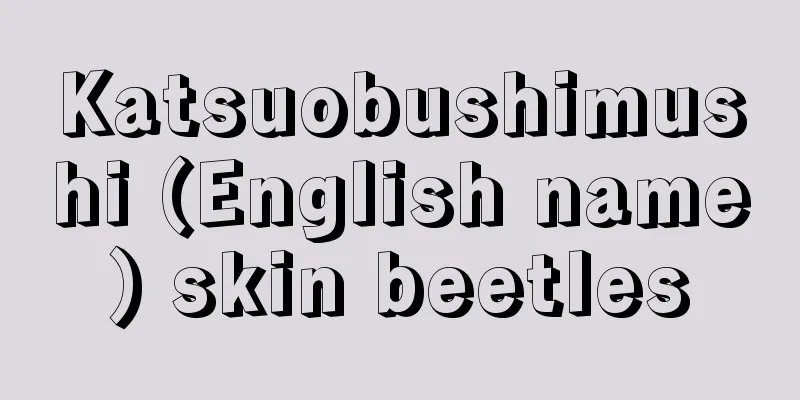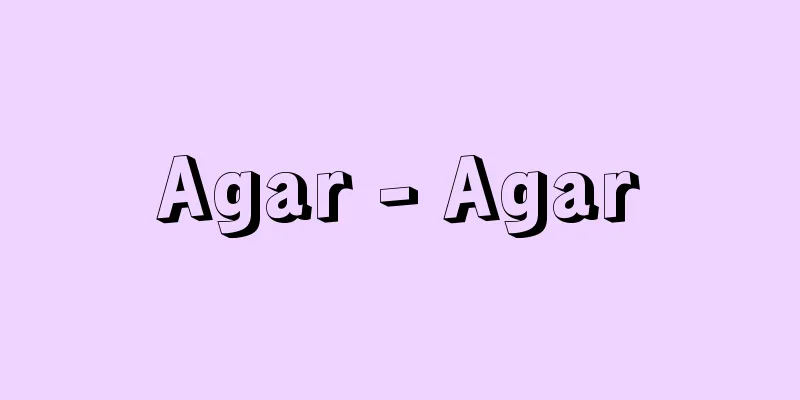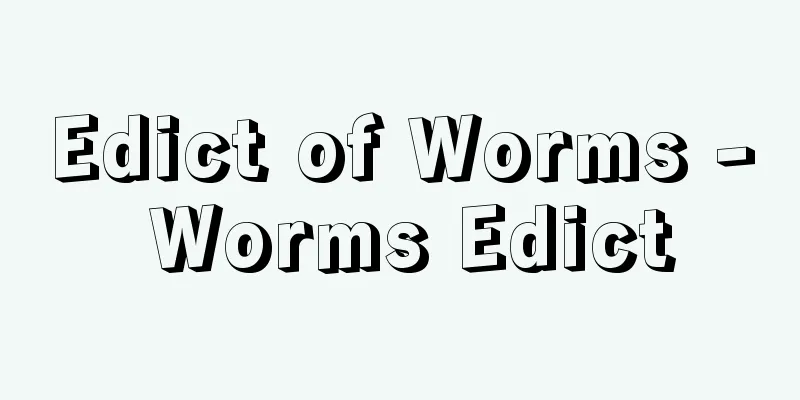Katsuobushimushi (English name) skin beetles

|
A general term for insects belonging to the family Dermestidae in the order Coleoptera of the class Insecta. Distributed widely throughout the world, with nearly 1,000 known species, over 20 of which have been recorded in Japan. The most conspicuous are those of the genus Dermestes , which are around 10 millimeters long and elliptical in shape, but others are usually elliptical to circular, measuring no more than a few millimeters, with a single eye between the compound eyes. Their antennae are short with several thick segments at the tip, but sometimes the last segment is abnormally large and circular or triangular. Species such as the genus Anthrenus have densely distributed scales on the surface of their bodies, creating spots. The larvae are often much longer and thinner than the adults, with horizontal rows of reddish-brown bristles on each segment and a long tuft of bristles at the tail, but the larvae of the genus Ploceum are wider at the back, inverted egg-shaped, and the bristles at the tail spread out like a peacock's tail feathers when they encounter an enemy. Both adults and larvae feed on dry animal matter, and sometimes vegetable matter, and many are considered important pests. Some members of the Attagenus are pests of stored grain, but many are pests of animal matter such as dried bonito flakes, dried fish, and leather, and are used to make skeletal specimens because they eat everything but the bones. The small, oval-shaped larvae of the Attagenus unicolor are known as pests of woolen fabrics, and the small, round-shaped adult Anthrenus verbasci can be seen on daisy flowers around May, but their larvae cause great damage by eating animal and plant specimens and woolen fabrics. In Europe, the same genus, A. museorum , is a major pest of specimens. Some members of the Thaumaglossa genus have unusual lifestyles, such as laying eggs in the egg masses of praying mantises, where the larvae grow. [Takehiko Nakane] ©Kanzo Otawa "> Main species of dermestid beetles [specimen illustrations] Source: Shogakukan Encyclopedia Nipponica About Encyclopedia Nipponica Information | Legend |
|
昆虫綱甲虫目カツオブシムシ科Dermestidaeに属する昆虫の総称。広く世界中に分布し、およそ1000種に近い種が知られ、日本からは、二十数種が記録されている。よく目につくのはカツオブシムシ属Dermestesのもので体長10ミリメートル前後、長楕円(ちょうだえん)形であるが、ほかのものは楕円形から円形が普通で数ミリメートル以下、複眼間に単眼が一つある。触角は短くて先端の数節が太いが、ときに先の1節が異常に大きく、円形や三角のことがある。マルカツオブシムシ属Anthrenusなどの種は体表に鱗片(りんぺん)を密布し斑紋(はんもん)をつくる。幼虫は、多くは成虫よりかなり細長く、各節に赤褐色の剛毛の横列があり、尾端に長い剛毛の束があるが、マルカツオブシムシ属の幼虫は後方が広がり、倒卵形で尾端の剛毛は敵にあうとクジャクの尾羽のように開く。成虫、幼虫とも乾いた動物質、ときには植物質を食べ、重要な害虫とされるものも多い。 カツオブシムシ属には貯穀の害虫もあるが、多くはかつお節、干魚、皮革など動物質の害虫で、骨を残してきれいに食べるので骨格標本の製作に利用される。小形で楕円形のヒメカツオブシムシAttagenus unicolorの幼虫は毛織物の害虫として知られ、小さく円形のヒメマルカツオブシムシAnthrenus verbasciの成虫は5月ごろマーガレットの花上にみられるが、幼虫は動植物標本、毛織物などを食べ大害を与える。ヨーロッパでも同属のアントレヌス・ムゼオルムA. museorumが標本の大害虫である。また、カマキリの卵塊に産卵寄生し、幼虫がその中で成育するカマキリタマゴカツオブシムシ属Thaumaglossaなど変わった生活をするものもある。 [中根猛彦] ©大多和鐘三"> カツオブシムシのおもな種類〔標本画〕 出典 小学館 日本大百科全書(ニッポニカ)日本大百科全書(ニッポニカ)について 情報 | 凡例 |
<<: Bonito and tuna fishing boats
Recommend
Kaschnitz, Marie Luise
Born January 31, 1901 in Karlsruhe [Died] October ...
Kumejima Tsumugi
A type of silk fabric. It is plain woven and mostl...
Innkeeper's Wealth
A classic Rakugo piece. A story from Osaka. It was...
Syphax
…In the early stages of the Second Punic War, he ...
Ant wall
〘 noun 〙 In a Japanese-style building, the wall be...
Angkor Empire
...However, as time went on, inscriptions written...
Spontaneous magnetization
...This phenomenon is called magnetic hysteresis....
Christian version - Kirishitanban
This refers to books and publications (Katsusa ed...
Extreme
A term used in the fields of earth and celestial ...
Diogenes Laertios
A Greek historian of philosophy from around the fi...
Processing trade on consignment - itakukakouboueki (English spelling)
This is a general term for forward consignment pr...
holding
...A type of ball game. Two teams of six (or nine...
Water ice
...They were especially popular in the post-World...
Ribe
〘 noun 〙 (Liebe)① (━ to do) love; romance; love af...
Karaman Principality (English spelling) Karamanoǧulları
A principality founded by Karamanoglu Mehmet Bey i...








![Organos [Mountains] - Organos](/upload/images/67cfdf98be24d.webp)
![Borzoi [species] (English spelling)](/upload/images/67ccde05da6f0.webp)